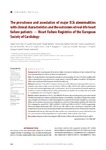Mostrar o rexistro simple do ítem
The prevalence and association of major ECG abnormalities with clinical characteristics and the outcomes of real-life heart failure patients - Heart Failure Registries of the European Society of Cardiology
| dc.contributor.author | Tyminska, Agata | |
| dc.contributor.author | Ozieranski, Krzysztof | |
| dc.contributor.author | Balsam, Pawel | |
| dc.contributor.author | Kaplon-Cieslicka, Agnieszka | |
| dc.contributor.author | Maciejewski, Cezary | |
| dc.contributor.author | Marchel, Michal | |
| dc.contributor.author | Crespo-Leiro, María Generosa | |
| dc.contributor.author | Maggioni, Aldo P. | |
| dc.contributor.author | Drozdz, Jaroslaw | |
| dc.contributor.author | Filipiak, Krzysztof J. | |
| dc.contributor.author | Opolski, Grzegorz | |
| dc.contributor.author | Grabowski, Marcin | |
| dc.date.accessioned | 2021-10-26T08:38:58Z | |
| dc.date.available | 2021-10-26T08:38:58Z | |
| dc.date.issued | 2021-06-02 | |
| dc.identifier.citation | Tyminska A, Ozieranski K, Balsam P, Kaplon-Cieslicka A, Maciejewski C, Marchel M, et al. The prevalence and association of major ECG abnormalities with clinical characteristics and the outcomes of real-life heart failure patients - Heart Failure Registries of the European Society of Cardiology. Kardiol Pol. 2021;79(9):980-987 | es_ES |
| dc.identifier.issn | 0022-9032 | |
| dc.identifier.uri | http://hdl.handle.net/2183/28721 | |
| dc.description.abstract | [Abstract] Background: Electrocardiogram (ECG) abnormalities increase the likelihood of heart failure (HF) but have low specificity and their occurrence is multifactorial. Aim: This study aimed to investigate the prevalence and association of major ECG abnormalities with clinical characteristics and outcomes in a large cohort of real-life HF patients enrolled in HF Registries (Pilot and Long-Term) of the European Society of Cardiology. Methods: Standard 12-lead ECG containing at least one of the following simple parameters was considered a major abnormality: abnormal rhythm; >100 bpm; QRS ≥120 ms; QTc ≥450 ms; pathological Q-wave; left ventricle hypertrophy; left bundle branch block. A Cox proportional hazards regression model was used to identify predictors of the primary (all-cause death) and secondary (all-cause death or hospitalization for worsening HF) endpoints. Results: Patients with abnormal ECG (1222/1460; 83.7%) were older, more frequently were male and had HF with reduced ejection fraction, valvular heart disease, comorbidities, higher New York Heart Association class, or higher concentrations of natriuretic peptides as compared to those with normal ECG. In a one-year follow-up, the primary and secondary endpoints occurred more frequently in patients with abnormal ECG compared to normal ECG (13.8% vs 8.4%; P = 0.021 and 33.0% vs 24.7%; P = 0.016; respectively). Abnormal rhythm, tachycardia, QRS ≥120 ms, and QTc ≥450 ms were significant in univariable (both endpoints) analyses but only tachycardia remained an independent predictor of the primary endpoint. Conclusions: HF patients with major ECG abnormalities were characterized by worse clinical status and one-year outcomes. Only tachycardia was an independent predictor of all-cause death. | es_ES |
| dc.language.iso | eng | es_ES |
| dc.publisher | Via Medica | es_ES |
| dc.relation.uri | https://doi.org/10.33963/KP.a2021.0053 | es_ES |
| dc.rights | Atribución-NoComercial-SinDerivadas 3.0 España | es_ES |
| dc.rights.uri | http://creativecommons.org/licenses/by-nc-nd/3.0/es/ | * |
| dc.subject | Cardiac resynchronization therapy | es_ES |
| dc.subject | Electrocardiogram | es_ES |
| dc.subject | QRS duration | es_ES |
| dc.subject | Left bundle brunch block | es_ES |
| dc.subject | Heart rhythm | es_ES |
| dc.title | The prevalence and association of major ECG abnormalities with clinical characteristics and the outcomes of real-life heart failure patients - Heart Failure Registries of the European Society of Cardiology | es_ES |
| dc.type | info:eu-repo/semantics/article | es_ES |
| dc.rights.access | info:eu-repo/semantics/openAccess | es_ES |
| UDC.journalTitle | Kardiologia Polska | es_ES |
| UDC.volume | 79 | es_ES |
| UDC.issue | 9 | es_ES |
| UDC.startPage | 980 | es_ES |
| UDC.endPage | 987 | es_ES |
Ficheiros no ítem
Este ítem aparece na(s) seguinte(s) colección(s)
-
INIBIC-ICATC - Artigos [174]







